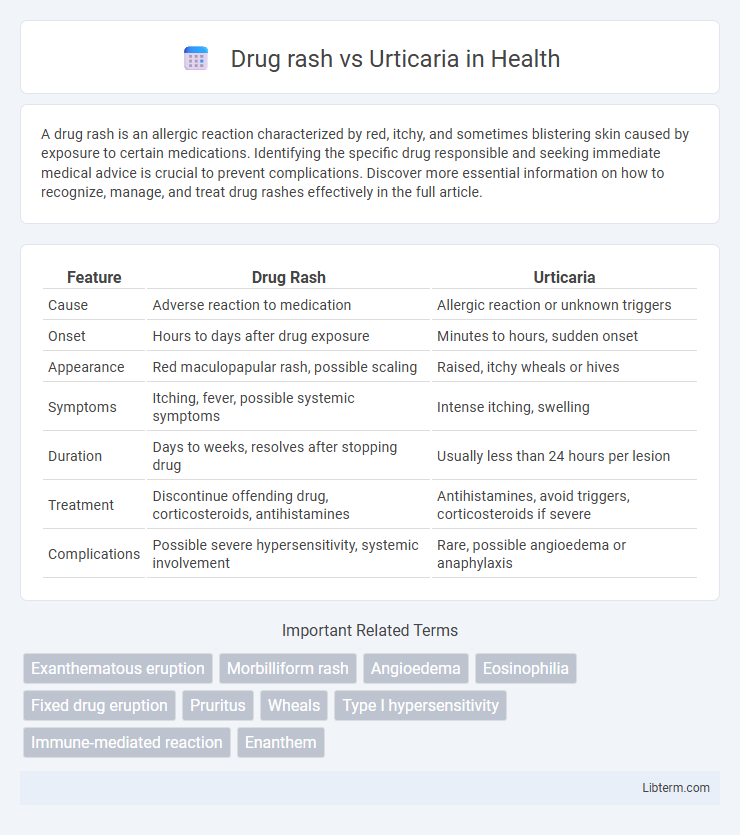A drug rash is an allergic reaction characterized by red, itchy, and sometimes blistering skin caused by exposure to certain medications. Identifying the specific drug responsible and seeking immediate medical advice is crucial to prevent complications. Discover more essential information on how to recognize, manage, and treat drug rashes effectively in the full article.
Table of Comparison
| Feature | Drug Rash | Urticaria |
|---|---|---|
| Cause | Adverse reaction to medication | Allergic reaction or unknown triggers |
| Onset | Hours to days after drug exposure | Minutes to hours, sudden onset |
| Appearance | Red maculopapular rash, possible scaling | Raised, itchy wheals or hives |
| Symptoms | Itching, fever, possible systemic symptoms | Intense itching, swelling |
| Duration | Days to weeks, resolves after stopping drug | Usually less than 24 hours per lesion |
| Treatment | Discontinue offending drug, corticosteroids, antihistamines | Antihistamines, avoid triggers, corticosteroids if severe |
| Complications | Possible severe hypersensitivity, systemic involvement | Rare, possible angioedema or anaphylaxis |
Introduction to Drug Rash and Urticaria
Drug rash is an adverse cutaneous reaction commonly triggered by medications, often presenting as widespread red, itchy, or blistering skin eruptions. Urticaria, also known as hives, is characterized by transient, raised, and intensely pruritic wheals caused by histamine release in response to allergens or triggers such as drugs. Differentiating between drug rash and urticaria is essential for appropriate diagnosis and management, as they involve distinct pathophysiological mechanisms and treatment approaches.
Defining Drug Rash
Drug rash is an adverse skin reaction triggered by medication, characterized by red, itchy, and inflamed patches that often appear within days of drug exposure. Unlike urticaria, which presents as transient, raised wheals or hives caused by allergic reactions, drug rash typically involves a more widespread and persistent eruption. Identifying the specific drug and discontinuing its use are critical steps in managing drug rash effectively.
Understanding Urticaria
Urticaria, commonly known as hives, presents as raised, itchy welts caused by the release of histamine from mast cells, often triggered by allergic reactions, infections, or stress. Unlike drug rashes, which typically appear as widespread red spots or patches due to medication hypersensitivity, urticaria lesions are transient and can change shape or location within hours. Effective management of urticaria involves identifying triggers and administering antihistamines to reduce histamine-induced swelling and itching.
Causes of Drug Rash
Drug rash primarily results from hypersensitivity reactions to medications such as antibiotics, nonsteroidal anti-inflammatory drugs (NSAIDs), and anticonvulsants, leading to immune-mediated skin inflammation. The pathophysiology involves activation of T-cells or immune complexes that cause widespread erythematous maculopapular eruptions. In contrast, urticaria is typically triggered by allergens, infections, or physical stimuli, with histamine release from mast cells causing transient wheals rather than fixed rashes.
Common Triggers of Urticaria
Urticaria commonly results from triggers such as allergic reactions to foods like shellfish and nuts, medications including antibiotics and nonsteroidal anti-inflammatory drugs (NSAIDs), insect stings, and environmental factors like pollen or pet dander. Physical stimuli such as pressure, temperature changes, and stress also frequently provoke hives. Differentiating urticaria from drug rash involves recognizing these specific triggers along with the characteristic raised, itchy wheals versus the broader, often less defined rash patterns seen in drug eruptions.
Key Differences Between Drug Rash and Urticaria
Drug rash typically presents as a widespread, symmetrical eruption with fixed lesions often accompanied by systemic symptoms such as fever, whereas urticaria manifests as transient, raised, itchy wheals that can migrate rapidly. Drug rashes are frequently caused by hypersensitivity reactions to medications and can last for days to weeks, contrasting with urticaria, which is usually triggered by allergic reactions, infections, or stress, and resolves within 24 hours. Diagnosis relies on clinical history, lesion appearance, and sometimes biopsy, with treatment differing significantly: drug rashes require discontinuation of the offending drug, while urticaria is managed with antihistamines and avoiding triggers.
Clinical Presentation and Symptoms
Drug rash commonly presents as widespread, symmetrical maculopapular eruptions often accompanied by itching and mild fever, typically appearing 1-2 weeks after drug exposure. Urticaria is characterized by transient, raised, erythematous wheals with intense pruritus, often resolving within 24 hours without residual skin changes. Both conditions involve immune-mediated skin reactions but differ in lesion morphology, duration, and systemic symptoms.
Diagnosis: Drug Rash vs Urticaria
Diagnosing drug rash versus urticaria involves evaluating the morphology, distribution, and timing of skin lesions in relation to drug exposure. Drug rashes often present as morbilliform eruptions with symmetric distribution, appearing days after initiating a new medication, whereas urticaria is characterized by transient, itchy wheals that resolve within 24 hours. Skin biopsy and detailed patient history are crucial to differentiate these conditions and guide appropriate treatment.
Treatment and Management Strategies
Drug rash treatment involves immediate discontinuation of the suspected medication and administration of antihistamines or corticosteroids to reduce inflammation and itching. Urticaria management focuses on identifying triggers, using non-sedating antihistamines as first-line therapy, and considering corticosteroids or immunomodulators for chronic or severe cases. Both conditions require close monitoring for potential progression to anaphylaxis, especially in drug-induced reactions.
Prevention Tips and When to Seek Medical Care
Preventing drug rash involves carefully following medication prescriptions, avoiding known allergens, and informing healthcare providers about drug allergies. Urticaria prevention includes reducing exposure to triggers such as certain foods, stress, and temperature changes. Seek medical care immediately if a drug rash or urticaria causes difficulty breathing, swelling of the face or throat, widespread blistering, or if symptoms worsen rapidly or persist beyond a few days.
Drug rash Infographic

 libterm.com
libterm.com